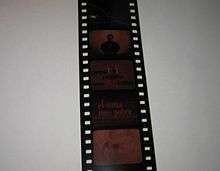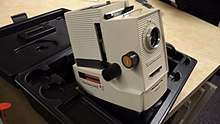Filmstrip
The filmstrip is a form of still image instructional multimedia, once commonly used by educators in primary and secondary schools (K-12), overtaken at the end of the 1980s by newer and increasingly lower-cost full-motion videocassettes and later on by DVDs. From the 1940s to 1980s, filmstrips provided an easy and inexpensive alternative to 16 mm educational films, requiring very little storage space and being very quick to rewind for the next use. Filmstrips were large and durable, and rarely needed splicing. They are still used in some areas.
Technology

A filmstrip is a spooled roll of 35 mm positive film with approximately thirty to fifty images arranged in sequential order. Like 16 mm film, a filmstrip was inserted vertically down in front of the projector aperture, rather than horizontally as in a slide projector. Therefore, the frame size is smaller than normal 35 mm film. Two image frames of a filmstrip take up the same amount of space as a single 35mm frame, including its guard band, so that a 25 exposure 35mm film can contain 50 filmstrip images. Early celluloid filmstrips had a habit of melting or combusting from the intense and sustained heat of the projection lamp. These were called pictural filmstrips, the first filmstrips that were produced in a complete set.
Typically, a filmstrip's running time was between ten and twenty minutes. Depending on how they were narrated or produced, filmstrips (which often came with an instructor's guide) were flexible enough to be used in both self-paced learning formats or a full classroom. In addition to a standard classroom wall or screen projector, personal film display units were available with a screen size of approximately eight inches diagonal for up-close viewing by one or two people.
The instructor would turn on a filmstrip projector that would show the first frame (image) of the filmstrip. The instructor then turned on a 33 RPM record or cassette tape containing the audio material for the filmstrip which included narration. At the appropriate point, a tone would sound, signaling the instructor to turn a knob, advancing to the next frame. Later, technical improvements allowed the projector to advance the film automatically.

Film production
By the later part of the 1960s, such firms as Warren Schloat Productions, CBS, The New York Times Company, Scott Education, Coronet Films, Sunburst Media, and Guidance Associates were producing titles featuring photographs by famous artists and of notable events with a synchronized audio track. The music and narration for the filmstrip originally came on a vinyl record.
In the 1970s, audio technology advanced, and vinyl records gave way to audio cassettes and became useful in providing individualized instruction. Students could now watch and listen to a filmstrip over and over at their own pace. Filmstrips also moved beyond traditional arts and humanities courses, branching into the science, career, vocational and technical subject areas led by such firms as Bergwall Productions[1] and Prentice Hall Media (Formerly Warren Schloat Productions.) There were filmstrips produced in many different subject areas including music, art, language arts, math, business and even home economics.
Home entertainment
In the early 1950s production companies started producing filmstrips for home entertainment. There were a number of films from Disney, and also from the Society for Visual Education Inc.(Chicago),[2] among other manufacturers.
Eastern Europe production
Film strips were popular in the USSR because movie projectors and VCRs were not in common use until the early 1990s. A great number of films were produced by the "Diafilm" studio. Many filmstrips were produced by "cinematographic studios" in former Soviet bloc countries such as Poland and Hungary during the 1950s–1960s.
In Greece they were known and sold by the name "tainies Argo Film" (ARGO FILM movies) from the name of the company (ARGO FILM) that translated the scripts into Greek and organized the productions' distribution in Greece. The titles included children's stories, fairy tales, Greek history, Christianity, adventure, science fiction and war stories.
Automatic film advance
During the 1970s, advanced projectors became available, and these projectors would automatically advance the film by means of a 50 Hz subaudible tone recorded on the cassette that would be detected by the projector, and automatically advance the frame. Most cassettes accompanying filmstrips in the 1970s and 1980s would have the same audio material on both sides of the tape. One side would have audible tones for the older projectors, and the other side would have the subaudible tones for the newer automatic projectors. Some select filmstrip releases had both audible and subaudible tones combined, making the filmstrip and its companion cassette compatible with any filmstrip projector. If improperly set up, the narration and film would not be synchronized.
From the late 1970s to the beginning of 1980, because most filmstrip publishers stopped making their sound filmstrip sets with LP records, audiovisual companies started producing automatic filmstrip projectors with built-in cassette players to better meet the audiovisual needs of teachers and school librarians. In 1979–1980 the DuKane Corporation in St. Charles, Illinois began to produce a cassette automatic filmstrip projector called the DuKane Micromatic II. This automatic filmstrip projector was easier to use by loading the filmstrip in the projector backward when the plastic upper film spring was flipped back. Loading the cassettes into the projector's cassette compartment was also easier with a control panel for the filmstrip and accompanying cassette. This filmstrip projector also had 50 Hz synchronization and could also be operated by remote control when set on manual mode. It was very popular with classroom and music teachers and school librarians. DuKane also produced a line of silent filmstrip projectors. The La Belle Commpak system used a 1000 Hz tone on 8-track tape to advance to the next slide. The General Electric Show'N Tell record system used 16mm for film, and record for audio.
Decline and obsolescence
The 1980s brought the advent of the video cassette recorder (VCR), and advancing technology meant increasingly affordable VCRs. When VCRs became within reach for most schools' budgets, this marked beginning of a decline in filmstrip use. Video instruction combined the ease of the filmstrip with automatically synchronized audio and full motion video. By the early 1990s, the vast majority of filmstrip producers that were not equipped to compete with video either closed or sold their businesses.
In the late 1990s to early 2000s, some audiovisual companies (such as Society for Visual Education Inc.,[2] Educational Audio Visual, and Metro Audio Visual) were still producing filmstrips for schools and libraries. When VHS, DVD, multimedia projectors and computers became popular in schools and libraries, however, filmstrips ceased to be used in schools, and many public libraries no longer had filmstrips in their catalogs. By the mid-2000s many schools no longer wanted to purchase filmstrips, and audiovisual companies stopped producing them.
See also
- Reversal film
- Show'N Tell
- Slide copier
- Slideshow
- ViewMaster
References
- "Home". Bergwall On Demand: Online Database of Instructional Videos For The Vocations. Retrieved 2020-03-28.
- Harvard University (1). Society for Visual Education Inc. Harvard University. Archived from the original on 6 October 2013. Retrieved 7 April 2013. Check date values in:
|year=(help)
External links

- Virtual Filmstrip Museum
- Historical filmstrips
- Deutsches Bildbandarchiv (German and international filmstrips from 1920 to 1980)